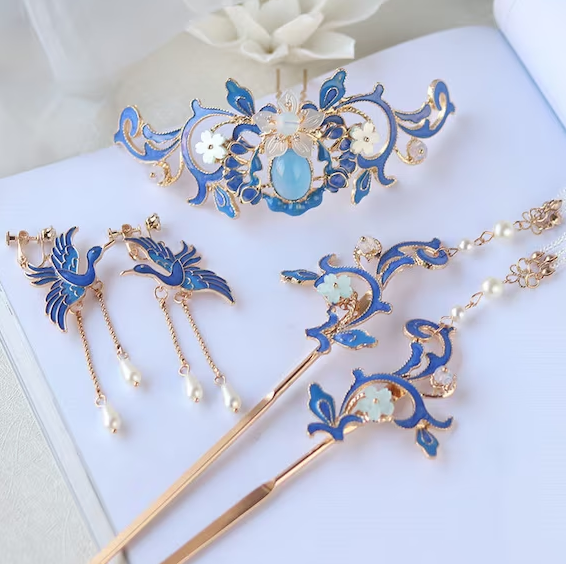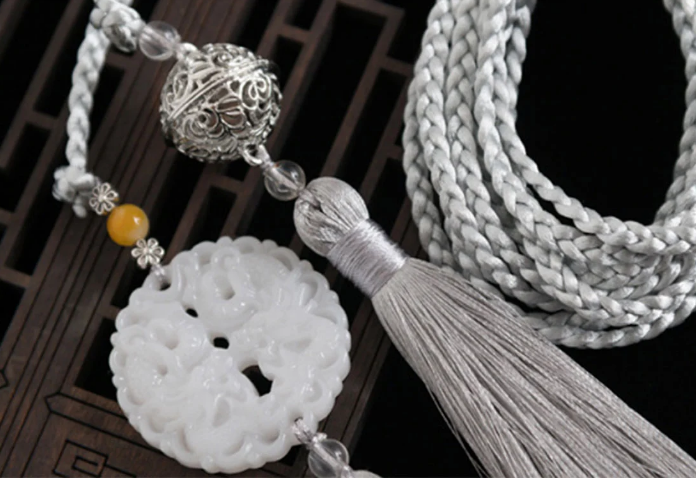Traditional Hanfu accessories included hair ornaments, jewelry, footwear, socks, belts, and sashes, each rich in cultural symbolism.
Main Hair Accessories in Traditional Hanfu Attire
Historical Significance of Hair Ornaments
In Chinese history, hair ornaments play a crucial role in Hanfu, the traditional attire of the Han Chinese. These accessories serve more than decorative purposes; they indicate the wearer’s social and marital status. For example, unmarried women in the Tang dynasty wore simple yet elegant ornaments, symbolizing their youth and purity. In contrast, married women chose more intricate designs, reflecting their changed social status. These practices, deeply rooted in Confucian ideals, emphasize propriety and social order.
Types of Traditional Hairpins and Combs
Exploring the variety, artisans craft traditional Chinese hairpins, known as ‘Zan’ or ‘Ji’, from materials like silver, jade, or gold, displaying the wearer’s wealth and status. They skillfully carve different designs and motifs, such as flowers, birds, or dragons, into these hairpins, making each a unique piece of art. For combs, another staple in Hanfu hair accessories, artisans often choose wood or bamboo, finding elegance in their simplicity and the natural beauty of the materials.

Symbolism in Hair Accessory Designs
Symbolism plays a vital role in these accessories. A hairpin with a phoenix motif, for example, signifies good fortune and high virtue, making it a popular choice for bridal accessories. The lotus flower, another common design, represents purity and beauty. These symbols are not random; they convey specific messages and wishes. In a society that values symbolism and hidden meanings, these hair accessories become a subtle yet powerful form of communication.
Each hair accessory in traditional Hanfu attire, from hairpins and combs to decorative hair ribbons, tells a unique story. These items are more than ornaments; they are symbols of a rich cultural heritage, revealing much about ancient Chinese culture and aesthetics.
Main Jewelry and Decorative Items
Necklaces and Pendants
Necklaces and pendants form a crucial part of traditional Hanfu attire, offering insight into the wearer’s status and personal aesthetics. Artisans typically craft these pieces from precious materials like jade, gold, and silver, symbolizing wealth and refinement. Jade, in particular, holds a special place in Chinese culture, often associated with purity and moral integrity. In the Han Dynasty, pendants frequently featured intricate carvings of mythical creatures, each carrying a specific symbolic meaning. For example, a dragon motif symbolized power and good fortune.
Bracelets and Rings
Bracelets and rings in Hanfu culture are not mere adornments; they carry deep cultural significance. Historically, people believed these items could ward off evil spirits and bring good luck. Gold and jade were the preferred materials, denoting luxury and class. The design of these pieces often varied according to the region and dynasty, reflecting the diverse artistic expressions across China. For instance, during the Ming Dynasty, bracelets with floral patterns were popular, symbolizing beauty and femininity.
Other Ornamental Pieces
Fans and brooches, though less discussed, are integral to Hanfu accessories. Fans, made from bamboo and silk, served both functional and aesthetic purposes. They often featured paintings or calligraphy, turning them into pieces of art. Brooches, used to fasten clothing or as hair ornaments, were typically made from metals like bronze and silver. They sometimes bore inscriptions or motifs, each with a unique story or symbolism, such as longevity or prosperity.
In conclusion, the jewelry and decorative items paired with traditional Hanfu are not just accessories; they are embodiments of rich cultural heritage and artistry. Each piece, whether a necklace, bracelet, or fan, tells a story of ancient China, revealing insights into the social norms, beliefs, and aesthetics of the times.
Main Footwear and Socks Accompanying Hanfu
Traditional Shoes
Traditional Chinese footwear, an essential part of the Hanfu ensemble, showcases a rich diversity in design and function. The most common types include cloth boots and embroidered shoes, often made from silk or cotton. These shoes, particularly popular during the Ming and Qing dynasties, feature intricate embroidery, displaying motifs like flowers, animals, and landscapes. Artisans tailor these designs to reflect cultural symbols and personal stories. For instance, the lotus flower, a recurring theme, symbolizes purity and elegance. Another popular style, the cloud shoe, features upturned toes and a unique shape, resembling a cloud.
Socks and Leggings
Socks and leggings, though less visible, play a vital role in the Hanfu attire. They are usually made from fine silk or soft cotton, ensuring comfort and elegance. The patterns and colors of these socks often match the overall outfit, creating a harmonious look. During colder months, people opt for thicker materials like wool to provide warmth. In historical records, it’s notable that socks with intricate patterns were a luxury item, often worn by the nobility. The designs on these socks, ranging from geometric patterns to natural scenes, carry significant cultural meaning, reflecting the wearer’s status and taste.
In summary, the footwear and socks accompanying traditional Hanfu are more than just functional items; they are a testament to the intricate artistry and cultural depth of ancient China. Each piece, from the elegantly embroidered shoes to the finely patterned socks, contributes to the holistic beauty and symbolism of the Hanfu attire.

Main Belts and Sashes in Hanfu Ensembles
The Role of Belts in Hanfu
In traditional Hanfu attire, belts are not just functional items; they hold significant cultural importance. These belts, often made of silk, brocade, or leather, help secure the layers of clothing and define the silhouette of the garment. Beyond their practical use, belts symbolize the wearer’s social status and personal style. In ancient times, the width, material, and color of the belt could indicate the wearer’s rank and occupation. For example, government officials in the Ming Dynasty wore belts with specific patterns and colors to denote their rank.
Varieties and Significance of Sashes and Ribbons
Sashes and ribbons add both beauty and symbolism to Hanfu ensembles. These accessories, usually crafted from fine silk, come in various colors and lengths, each with its own meaning. A long, flowing ribbon, for instance, symbolizes elegance and grace, often used in formal attire. In contrast, shorter sashes might be worn for daily activities. The color choice is equally important, as different colors convey different emotions and messages. Red, a popular color for sashes, represents happiness and good fortune, often seen in wedding attire.
In conclusion, belts, sashes, and ribbons in Hanfu attire serve more than a practical purpose. They are key elements that contribute to the beauty and cultural significance of the garment. Each piece, carefully chosen for its material, color, and length, reflects the wearer’s identity and the rich traditions of Chinese culture.







